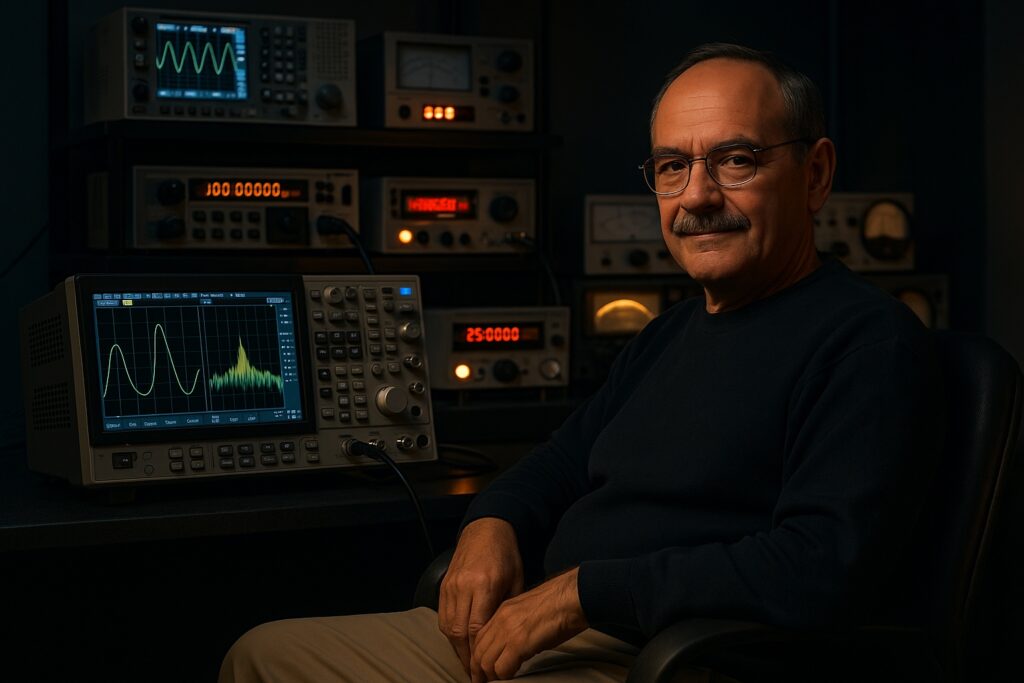Selectivity and Sensitivity in NBFM Receivers: Fundamental Performance Parameters
Contents
In the context of wireless communications, the quality and performance of a receiver are crucial factors that determine the reliability and efficiency of a system. In Narrowband Frequency Modulation (NBFM), two key parameters hold particular importance: receiver selectivity and receiver sensitivity.
Selectivity defines the receiver’s ability to distinguish the desired signal from interference on adjacent frequencies, while sensitivity represents the minimum signal strength required for reliable detection and demodulation. These parameters directly affect the overall receiver performance, particularly in environments with high spectral congestion and low signal levels.
Selectivity
The selectivity of a Narrowband Frequency Modulation (NBFM) receiver is defined as its ability to isolate and receive a desired signal while simultaneously rejecting unwanted signals located on nearby frequencies. This parameter is critical in radio communication environments with high spectral density, where multiple signals are transmitted on adjacent channels.
Selectivity is primarily determined by the characteristics of the RF (Radio Frequency) and IF (Intermediate Frequency) filters incorporated in the receiver, as well as the overall bandwidth. Adequate selectivity levels enable effective suppression of adjacent channel interference, reduce noise, and improve output signal quality. This performance is commonly measured as the power ratio between the desired and undesired signals at a predefined frequency offset.
Measurement of Selectivity
Required Equipment
- Two RF signal generators (one for the desired and one for the interfering signal)
- T-type coupling network to combine both signals at the receiver input
- 1 kHz high-pass filter to isolate the output signal
- An audio level meter (SINAD meter) for output signal analysis
Setup: Generator – Coupler – Receiver – Filter – SINAD Meter
Measurement Procedure
Adjustment of the Desired Signal:
Initially, only the desired signal is applied at the receiver’s operating frequency, modulated with a 1000 Hz tone and a deviation of 60% of the maximum allowed (standard test modulation).
The level of the desired signal is adjusted to the maximum usable sensitivity, so that the SINAD ratio (Signal + Noise + Distortion to Noise + Distortion) at the receiver output is 20 dB.
The ratio is expressed as:
(Signal + Noise + Distortion) / (Noise + Distortion)
Note on RF Measurements:
According to the CEPT/ERC 74-01E (formerly CEPT-17) standard, RF signal levels are expressed as Electromotive Force (EMF).
In the receiver specifications, levels are typically expressed as voltage into a 50Ω termination (IEC 60315 standard) and are 6 dB lower than the corresponding CEPT-17 values.
Adjustment of the Undesired Signal:
Next, the interfering signal is applied at the adjacent channel frequency, modulated with a 400 Hz tone and the same deviation (60%).
The level of the interfering signal is gradually increased until the SINAD ratio at the output drops from 20 dB to 14 dB.
This measurement is repeated for both upper and lower adjacent channels.
Selectivity Calculation:
Selectivity is expressed as the ratio of the interfering signal level to the desired signal level in decibels (dB).
For example, if the desired signal level at the receiver input is 1 μV, and the interfering signal needs to reach 50 μV to degrade the SINAD by 6 dB, then the adjacent channel selectivity is:
20 log(50 / 1) = 34 dB (log 50 ≈ 1.698)
The final adjacent channel selectivity value is the lower of the two values measured for the upper and lower adjacent channels.
Having examined how selectivity affects a receiver’s ability to isolate a desired signal from adjacent channel interference, it is equally important to understand sensitivity.
Sensitivity defines the lowest signal level that can be detected and reproduced by the receiver with acceptable quality. Both parameters are complementary and are essential for selecting a receiver in low-signal or high-activity environments.
Sensitivity
Receiver sensitivity is defined as the minimum input signal level at the designated receiving frequency required for the receiver output to achieve an acceptable signal-to-noise and distortion ratio. In other words, it is the threshold below which the receiver can no longer distinguish the signal from noise.
Sensitivity Measurement Standards
1. According to CEPT/ERC 74-01E (formerly CEPT-17):
Defined as the minimum input signal that provides a 20 dB SINAD at the output.
2. According to IEC 60315 (International Electrotechnical Commission Standard)
Defined as the minimum input signal that provides a 12 dB SINAD at the output.
3. Quieting Method (S/N = 20 dB):
In this method, the signal is considered unmodulated, so distortion is excluded.
Although this method produced better sensitivity figures, it was abandoned due to lack of objectivity.
Comparison of CEPT/ERC 74-01E and IEC 60315 Standards
There is an 8 dB difference between these two standards. A receiver with 0.5 μV sensitivity per IEC 60315 is equivalent to one with 1.25 μV sensitivity per CEPT/ERC 74-01E, because:
20 log(1.25 / 0.5) = 8 dB
SINAD Weighting Correction
Sensitivity measurement is performed using a SINAD-weighted filter, which simulates the human ear’s frequency response to give a more representative acoustic experience.
Typical Values for Selectivity and Sensitivity in NBFM Receivers
| Parameter | Typical Value | Measurement Conditions / Notes |
|---|---|---|
| Sensitivity (12 dB SINAD) | 0.20 – 0.35 μV | @ 12 dB SINAD, 1 kHz deviation, 1 kHz AF, 50Ω input |
| Sensitivity (BER 1%) | -116 to -120 dBm | Digital measurement for systems with FEC |
| Selectivity (±6.25 kHz) | ≥ 60 dB | Adjacent Channel Selectivity @ ±6.25 kHz Offset |
| Selectivity (±12.5 kHz) | ≥ 70–75 dB | Narrowband, 12.5 kHz channel spacing |
| Selectivity (±25 kHz) | ≥ 80 dB | Wideband, for legacy comparison |
| AF Signal-to-Noise Ratio | ≥ 45–55 dB | @ 1 kHz modulation tone, 3 kHz deviation |
| Intermodulation Rejection | ≥ 65–75 dB | Typically measured with two interferers at ±400 kHz |
| Spurious Response Rejection | ≥ 70–80 dB | Rejection of out-of-band signals |
These values are indicative and may vary depending on the receiver type (e.g., handheld, base station, SDR) and manufacturer.
Most professional standards (e.g., ETSI EN 300 086 for PMR) require adjacent channel selectivity greater than 60 dB.
Sensitivity is commonly measured using the 12 dB SINAD method, which represents acceptable audio quality for analog receivers.
In modern SDR (Software Defined Radio) receivers, sensitivity is influenced not only by the RF front-end but also by digital signal processing (DSP).
Conclusion
Understanding and accurately measuring the key parameters of selectivity and sensitivity is fundamental for the technical evaluation and proper selection of an NBFM receiver according to the radio station’s requirements. Selectivity determines the receiver’s capability to isolate the desired signal from adjacent interference, ensuring reliable reception even in spectrally congested environments. Conversely, sensitivity represents the lowest input signal level that can be detected and demodulated with acceptable quality.
Both parameters are critical to the overall performance of a narrowband receiver, as they directly influence behavior under weak signal or high-interference conditions. A thorough understanding of these characteristics allows amateur operators or technical professionals to objectively compare different models and choose equipment based on documented specifications rather than subjective experience.
Referencing and complying with international measurement standards, such as CEPT/ERC Recommendation 74-01E (formerly CEPT-17) and IEC 60315, provides a consistent and comparable framework for evaluation. Through these, technical specifications gain measurable value and facilitate comparative analysis between receivers from different manufacturers.
Ultimately, the choice of a receiver should not be left to chance but should be the result of knowledge, technical analysis, and adherence to internationally accepted criteria.






